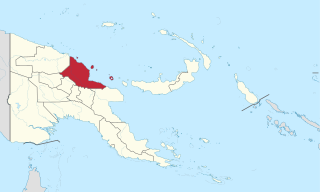
Madang is a province of Papua New Guinea. The province is on the northern coast of mainland Papua New Guinea and has many of the country's highest peaks, active volcanoes and its biggest mix of languages. The capital is the town of Madang.
The Yuat languages are an independent family of five Papuan languages spoken along the Yuat River in East Sepik Province, Papua New Guinea. They are an independent family in the classification of Malcolm Ross, but are included in Stephen Wurm's Sepik–Ramu proposal. However, Foley and Ross could find no lexical or morphological evidence that they are related to the Sepik or Ramu languages.
Sulka is a possible language isolate scattered across the eastern end of New Britain island, Papua New Guinea. In 1991, there were 2,500 speakers in eastern Pomio District, East New Britain Province. Villages include Guma in East Pomio Rural LLG. With such a low population of speakers, this language is considered to be endangered.
Dadibi is a language of Papua New Guinea. In 2001, the whole Bible was translated into Dadibi.
Waris or Walsa is a Papuan language of northern New Guinea.
Amanab is a Papuan language spoken by 4,400 people in Amanab District, Sandaun Province, Papua New Guinea.

Today, there are 851 languages spoken in Papua New Guinea. These languages are spoken by the tribal groups inhabiting Papua New Guinea and Indonesia. In 2006, Papua New Guinea Prime Minister Sir Michael Somare stated that "Papua New Guinea has 832 living languages ," making it the most linguistically diverse place on Earth. Its official languages are Tok Pisin, English, Hiri Motu, and Papua New Guinean Sign Language. Tok Pisin, an English-based creole, is the most widely spoken, serving as the country's lingua franca. Papua New Guinean Sign Language became the fourth official language in May 2015, and is used by the deaf population throughout the country.

This page is a list of districts of Papua New Guinea.
The Kwalean languages are a small family of Trans–New Guinea languages spoken in the "Bird's Tail" of New Guinea. They are sometimes included in a speculative Southeast Papuan branch of Trans–New Guinea (TNG), but the Southeast Papuan families have not been shown to be any more closely related to each other than they are to other TNG families.

Pawaia, also known as Sira, Tudahwe, Yasa, is a Papuan language that forms a tentative independent branch of the Trans–New Guinea family in the classification of Malcolm Ross (2005).
Bogaya (Pogaya) is a Papuan language of Papua New Guinea. In Western Province, Bogaya is spoken in Olsobip Rural LLG and Nomad Rural LLG. It is also spoken in Koroba-Kopiago District, Hela Province.
Namia is a Sepik language spoken in Sandaun Province, Papua-New Guinea. It goes by various names, such as Edawapi, Lujere, Yellow River. Language use is "vigorous" (Ethnologue).
Foia Foia (Foyafoya), or Minanibai, is a Papuan language of Papua New Guinea, spoken in an area near Omati River mouth in Ikobi Kairi and Goaribari Census districts.
Elias Kapavore is a Papua New Guinean politician. He has been a member of the National Parliament of Papua New Guinea since May 2015, representing the electorate of Pomio Open in East New Britain Province.

Central-Inland Pomio Rural LLG is a local-level government (LLG) of East New Britain Province, Papua New Guinea.

East Pomio Rural LLG is a local-level government (LLG) of East New Britain Province, Papua New Guinea. The Sulka language is spoken in the LLG, including in the village of Guma.

West Pomio-Mamusi Rural LLG is a local-level government (LLG) of East New Britain Province, Papua New Guinea. The Upper dialect of the Ata language is spoken in the LLG.









